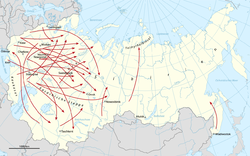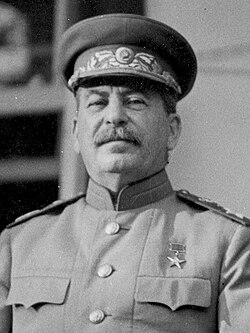
Population transfers in the Soviet Union were forced transplantations of groups that occurred in the USSR during the dictatorship of Joseph Stalin. These deportations and mass movements began in 1930 as part of the Soviet policy of agricultural collectivization, as the Soviet government forced people off of their own farms. Later this policy of population transfers was extended to the mass transplantation of ethnic groups such as the Crimean Tatars, Chechens and Koreans in an effort to crush any form of political dissent in the Caucasus, Central Asia, the Far East and other regions. These policies are now viewed as ethnic cleansing. Millions of people were transferred around the Soviet Union and Russia in particular through these policies. Forced population transfers were largely abandoned at the end of Stalin's dictatorial rule in 1953. Millions of people around Russia and former constituent parts of the USSR will have an ancestor who was forced to move hundreds or thousands of kilometers across Eurasia during the Stalinist era because of the population transfers.[1]
Research your ancestors on MyHeritage
Soviet population transfers chronology of eventsSoviet population transfers chronology of events
The Union of Soviet Socialist Republics emerged at the start of the 1920s out of the Russian Civil War as a huge entity which ruled territory stretching from Belarus and Ukraine in the west to the Pacific Ocean in the east and from the White Sea in the north to the South Caucasus and Central Asia in the south. There were many ethnic minorities within this massive state, the largest in the world, from Chechens and Georgians in the Caucasus to Koreans and Uighurs in the east. This was also a hugely unequal country, one which had been dominated by large landholders for centuries and where much of the population were extremely poor, serfdom only having been abolished in 1861, centuries after it had effectively come to an end in most European countries. Trying to overturn this situation and create a rigidly egalitarian society in line with communist ideology would create problems which would result in population transfers.[2]

Population transfers in the Soviet Union are synonymous with the dictatorial reign of Joseph Stalin, who gradually monopolized power in the mid-1920s following the death of Vladimir Lenin and who ruled as a dictator from around 1926 down to his death in 1953. This being said, the overseers of the population transfers on Stalin’s behalf were a number of senior Soviet officials like Lavrentiy Beria, the People’s Commissar for Internal Affairs and head of the secret police forces in the USSR.[3]
The first wave of population transfers took place in the early 1930s and was primarily economic and ideological. This was at the height of the policy of agricultural collectivization, whereby landholders had their farms taken from them and formed into large Soviet collective farms, the goal being to introduce a more efficient state-run agricultural sector. This led to resistance in many instances and those who resisted were soon being transplanted hundreds or thousands of kilometers from their homes to other parts of Russia in an effort to quell any resistance. In other cases smallholders known as kulaks who owned as little as ten acres were viewed as ideological enemies of the state and were transferred to other parts of the country.[4]
Later this economic and ideological system of population transfers was adopted as a means of dealing with perceived ethnic enemies of the state. For instance, in the autumn of 1941, following the Nazi invasion of the USSR during the Second World War, hundreds of thousands of ethnic Germans living within the lands of the USSR were collectively blamed for the actions of Germany and were removed to extremely harsh conditions in Siberia where many died. After the German onslaught on Russia had been defeated and the Russians pushed the Germans back into Ukraine and Poland, collective punishment was enacted against ethnic groups who were adjudged to have collaborated with the Germans in the occupied territories. These included groups such as the Crimean Tatars, the Kalmyks, and Chechens in the Caucasus and lands north of the Black Sea and Finns in north-western Russia, while various groups in the Far East and Central Asia were included in these ethnic population transfers, which amounted to forms of ethnic cleansing.[5]
Extent of the population transfersExtent of the population transfers

The extent of the forced migration was immense. As many as seven million people were involved between the late 1920s and the death of Stalin in 1953. Around two million kulaks and peasants were forcibly relocated in the 1930s. By some estimates over a million people of German ethnicity were transferred during the Second World War. Nearly 70,000 Karachays, a Turkish-speaking people from the North Caucasus, were relocated to Central Asia around modern-day Kyrgyzstan. 93,000 Kalmyks, a Buddhist people living in south-western Russia, were expelled to Siberia where a large proportion died owing to the cold and poor conditions. One of the largest ethnic transplantations was that of the Chechens and Ingush, two Muslim groups of the Caucasus, who were relocated to Central Asia around modern-day Kazakhstan and other parts of the USSR east of the Ural Mountains.[6]
While the numbers declined once the Second World War ended, forced migration still continued for some groups, notably the forced transplantation of upwards of 100,000 Moldovans around 1950 to various parts of central Russia and Siberia. In many of these instances the figures are disputed. For instance, in the case of the Moldovan population transfer, older studies suggested a figure as high as quarter of a million. Some argue it was as low as 28,000. What is clear is that millions of people were transferred across the Soviet Union between the late 1920s and 1953.[7]
Demographic impact of the population transfersDemographic impact of the population transfers
The demographic impact of these transfers was very substantial. Because of them there are large ethnic communities of groups like the Chechens, Crimean Tatars, Kalmyks, Finns and Moldovans in parts of Central Asia, central Russia and Siberia today which otherwise would not exist. Conversely, the communities of these groups which previously existed in Russia west of the Ural Mountains and particularly in the Caucasus region were hugely diluted. In this regard, the population transfers were a more extreme version of the program of Russification which existed in the nineteenth and early twentieth centuries in the era of the Russian Empire.[8]
Research Russian ancestors on MyHeritageResearch Russian ancestors on MyHeritage
Research your ancestors on MyHeritage
See alsoSee also
Explore more about Soviet population transfersExplore more about Soviet population transfers
- Former Russian Empire, World War I Casualties records collection on MyHeritage
- Russia, Births and Baptisms, 1755-1917 records collection on MyHeritage
- Russia, Marriages, 1793-1919 records collection on MyHeritage
- Russia, Cemetery Records records collection on MyHeritage
- Where is That? Using Eastern European Atlases, Maps and Gazetteers at Legacy Family Tree Webinars
- Researching Eastern European Archives from Your Easy Chair at Legacy Family Tree Webinars
References
- ↑ https://www.sciencespo.fr/mass-violence-war-massacre-resistance/fr/document/soviet-massive-deportations-chronology.html
- ↑ https://www.lib.uchicago.edu/collex/exhibits/soviet-imaginary/socialism-nations/soviet-policy-nationalities-1920s-1930s/
- ↑ J. Otto Pohl, ‘The Deportation of the Crimean Tatars in the Context of Settler Colonialism’, in International Crimes and History, Vol. 16 (2015).
- ↑ https://www.sciencespo.fr/mass-violence-war-massacre-resistance/en/document/dekulakisation-mass-violence.html
- ↑ Terry Martin, ‘The Origins of Soviet Ethnic Cleansing’, in The Journal of Modern History, Vol. 70, No. 4 (December, 1998), pp. 813–861.
- ↑ https://www.sciencespo.fr/mass-violence-war-massacre-resistance/fr/document/soviet-massive-deportations-chronology.html
- ↑ Bohdan Nahajlo, ‘Forcible Population Transfers, Deportations and Ethnic Cleansing in the CIS: Problems in Search of Responses’, in Refugee Survey Quarterly, Vol. 16, No. 3 (1997), pp. 26–76.
- ↑ https://www.ieg-ego.eu/en/threads/models-and-stereotypes/russification-sovietization

